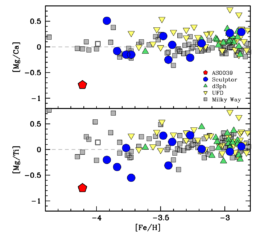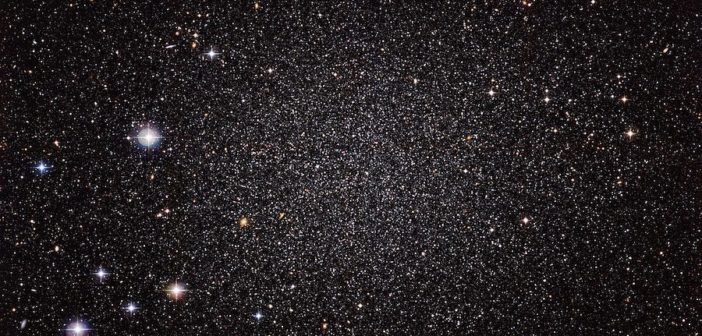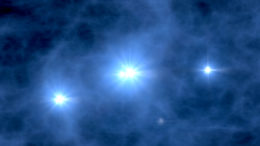Editor’s note: Haley Wahl is a fifth-year graduate student at West Virginia University, and she was recently selected as the 2021–2022 AAS Media Fellow. We’re excited to welcome Haley to the team and look forward to featuring her writing on AAS Nova regularly!
The first stars to light up the cosmos have so far eluded astronomers. However, new research may now have uncovered these obscure objects in the dusty recesses of a dwarf galaxy 300,000 light-years away.
An Elusive Population
The birthplaces of stars are clouds of gas and dust hundreds of times bigger than our solar system. These nebulae can be formed in a variety of ways and are often the leftover material from a previous star that ended its life in a violent supernova explosion. If this is the case, the nebula can contain elements manufactured in the star that exploded, such as carbon and magnesium, as well as heavier elements forged in the supernova itself, such as silver. Stars that were formed in the aftermath of a supernova contain traces of all these elements.
Based on their composition, stars can be categorized into three populations: Population I stars, which are young metal-rich stars (“metals” here are elements heavier than helium); Population II stars, which are metal-poor stars that started forming early on in the universe when it was only a few billion years old; and Population III stars, which are extremely bright, hot stars that contain almost no metals, only hydrogen, and formed in the earliest stages of the universe. Population III stars represent some of the first stars formed after the Big Bang, and they could provide new insights into what our universe was like when it was only ~800 million years old.Population III stars have never been observed, only hypothesized, but a team of astronomers led by Ása Skúladóttir (University of Florence, Italy) may be closer than ever to observing these elusive astronomical wonders.
Searching Spectra
The star AS0039 was discovered in the dwarf galaxy Sculptor as part of a large survey done by the European Southern Observatory and observed more in-depth via spectroscopy with the Very Large Telescope/X-Shooter instrument, which reveals the composition of the star. Using the effective temperature of the star obtained from Gaia data, the gravity obtained through photometry, the microturbulent velocity measured through empirical calibration, and a stellar atmospheric model, the team performed spectral analyses on the star to determine its chemical composition.

The ratio of abundances of different metals in stars in AS0039’s host galaxy (blue), dwarf spheroidal galaxies (dSph; green), ultra-faint dwarf galaxies (UDF; yellow), and the Milky Way (gray). AS0039’s metal abundances, shown in red, are unlike the stars in any of these galaxies. [Skúladóttir et al. 2021]
These abundances of AS0039 are characteristic of elements formed in a hypernova, a giant explosion bigger than a supernova that occurred at the beginning of the universe when stars were more massive. By comparing AS0039’s abundances to those from simulations of Population III supernovae over a wide range of progenitor masses and explosive energies, the authors determined that AS0039 was likely born from the material left over after a star 21 times the mass of the Sun exploded as a hypernova. This discovery provides a link between the current generation of stars and their elusive Population III ancestors.
Future Work
Before this star was spotted, there was only weak evidence of Population III stars from the imprints of low-energy supernovae seen in carbon-enhanced metal-poor stars. The massive star that enriched the material from which AS0039 formed is unlike any star seen before, but this single discovery allows us to probe only a tiny subset of all the possible properties of Population III stars. The discovery of AS0039 will allow astronomers to study these stars in a different light, by probing them through the remnants of the massive explosions of the first stars. Future developments in theoretical simulations and larger spectroscopic surveys will bring astronomers one step closer to solving the mystery of what the first stars were like.
Citation
“Zero-metallicity Hypernova Uncovered by an Ultra-metal-poor Star in the Sculptor Dwarf Spheroidal Galaxy,” Ása Skúladóttir et al 2021 ApJL 915 L30. doi:10.3847/2041-8213/ac0dc2


